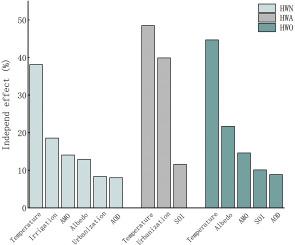Atmospheric Research ( IF 5.5 ) Pub Date : 2021-01-08 , DOI: 10.1016/j.atmosres.2021.105458 Xiaojun Wu , Lunche Wang , Rui Yao , Ming Luo , Xin Li

|
The driving factors of heat waves (HW) have been analyzed widely, but the relative importance of these factors is still poorly understood. In this study, the temporal and spatial variations of HW in the North China Plain (NCP) were investigated using meteorological datasets during 1961–2014. The relationship between HW and several potential driving factors related to climate change (air temperature, precipitation and solar radiation), anthropogenic activity (urbanization, irrigation and aerosol optical depth (AOD)), land-surface interaction (soil moisture, drought and land surface albedo) and atmospheric circulation were assessed. The relative importance of these factors was revealed based on all-subsets regression and hierarchical partitioning (HP) analysis. Results showed that HW in the NCP became increasingly intense, frequent, durable, and emerged earlier and terminated later, with a significant increased slope in intensity, frequency duration and timing. Spatially, greater upward trends were observed in the northern NCP. Climate warming, urbanization, irrigation, AOD, land surface albedo and Atlantic Multidecadal Oscillation were significantly correlated with HW. Based on HP analysis, the most important driving factor was climate warming, contributing approximately 40% to HW variation. The cumulative contribution rate of anthropogenic activity to the HW frequency, duration and amplitude reached nearly 35%. The AMO and land surface albedo explained approximately 15% and 20% of the HW variation, respectively. This study helps to understand the characteristics of regional extreme heat events and provides a scientific basis for developing HW alleviation strategies.
中文翻译:

确定华北平原热浪的主要驱动因素
人们已经对热波(HW)的驱动因素进行了广泛分析,但是对这些因素的相对重要性仍然知之甚少。在这项研究中,使用气象数据集研究了华北平原(NCP)在1961-2014年间的硬件时空变化。硬件与几个潜在驱动因素之间的关系,这些潜在驱动因素与气候变化(气温,降水和太阳辐射),人为活动(城市化,灌溉和气溶胶光学深度(AOD)),地表相互作用(土壤湿度,干旱和地表)有关反照率)和大气环流进行了评估。这些因素的相对重要性基于所有子集回归和层次划分(HP)分析得以揭示。结果表明,NCP中的硬件变得越来越紧张,频繁,持久,并出现得较早,后来终止,强度,频率持续时间和时序的斜率显着增加。从空间上看,北部NCP的上升趋势更大。气候变暖,城市化,灌溉,AOD,地表反照率和大西洋多年代际涛动与硬件显着相关。根据HP分析,最重要的驱动因素是气候变暖,对硬件变化的贡献约为40%。人为活动对硬件频率,持续时间和幅度的累积贡献率达到近35%。AMO和陆面反照率分别解释了HW变化的大约15%和20%。该研究有助于了解区域极端高温事件的特征,并为制定硬件缓解策略提供科学依据。



























 京公网安备 11010802027423号
京公网安备 11010802027423号